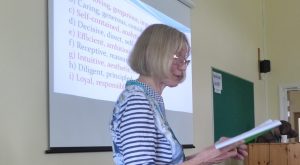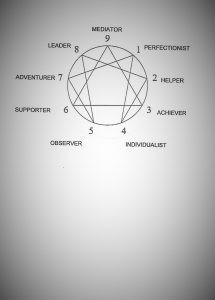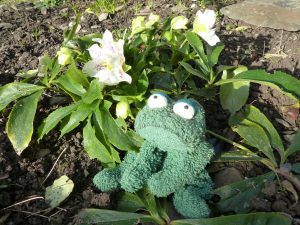 Maybe you came to my course on the Enneagram at the Swanwick Writer’s Summer School last year, or you’re already familiar with it.
Maybe you came to my course on the Enneagram at the Swanwick Writer’s Summer School last year, or you’re already familiar with it.
Welcome to a refresher taste.
Maybe you’ve never heard of the the Enneagram. In which case, welcome to all first time learners.
What is the Enneagram?
Rosemary Cowan of the London Enneagram Centre writes:
The Enneagram is a comprehensive guide to personality types, based on a number of ancient wisdom traditions. It’s a tool for understanding human nature. It shows us the unconscious motivations behind the ways we react, when we are secure, and when we are stressed. When we study the Enneagram, we can understand more about why people think, feel, and act the way they do.
The Enneagram can help a writer create realistic and believable characters.
At the same time, one of the outcomes of studying it is that we can get to know and understand ourselves better too.
Before we get going, please read the following:
FIVE THINGS TO NOTE
 You were born with your personality type. You may change and grow in some ways, and be affected positively or adversely by circumstances, but your basic personality type will not change.
You were born with your personality type. You may change and grow in some ways, and be affected positively or adversely by circumstances, but your basic personality type will not change.- Not everything in the notes about your personality type will apply to you.
- It is common to find something of yourself in all the personality types, but after a little or a lot of consideration, one of them should emerge as being closest to yourself. This is your basic personality type.
- If you are meeting the Enneagram for the first time, don’t be in a hurry to ‘label’ yourself. And I’m sorry, as much as you would like to be a particular number, you can’t pick and choose which group to be in!
- The numbers are arbitrary. It isn’t better to be a Four than a Six, or a Nine than an Eight. A One isn’t the crême de la crême, being the first number, neither is Nine, perched on top of the Enneagram diagram. All are of equal worth.
INTRODUCING THE NINE PERSONALITY TYPES
 To begin our study, we’re going to have an overview of the nine distinct personality types, illustrated in the diagram. Each has many excellent qualities, as well as a few less desirable qualities. After all, we are human, made up of good and not-so-good. So, here we go:
To begin our study, we’re going to have an overview of the nine distinct personality types, illustrated in the diagram. Each has many excellent qualities, as well as a few less desirable qualities. After all, we are human, made up of good and not-so-good. So, here we go:
1 PERFECTIONISTS believe they must be good and right to be worthy. They are dependable, principled, and conscientious, but they can also be resentful and critical, and they can judge themselves harshly.
2 HELPERS believe they must give fully and unceasingly in order to be loved. They are warm-hearted, considerate, and sensitive to the needs of others, but they can be prideful, demanding and intrusive.
3 ACHIEVERS believe they must accomplish much and be successful in order to be loved. They are industrious, self-confident, and goal-orientated, but they can be unmindful of feelings, image-driven and lacking in patience.
4 INDIVIDUALISTS believe they must obtain an ideal relationship or situation in order to be loved. They are sensitive, intuitive, and empathetic, but they can be moody or dramatic, and they sometimes become self-absorbed.
5 OBSERVERS believe they must protect themselves from an over-demanding world. They are perceptive, analytical, and knowledgeable, and they seek self-sufficiency. However, they can be overly-private and detached.
6 SUPPORTERS believe they must gain security and protection in a world they can’t entirely trust. They are responsible, trustworthy, and loyal, but they can also be fearful, doubtful and accusatory.
7 ADVENTURERS believe they must live to the full, all the time, in order to have a good life. They are energetic, optimistic, and fun-loving They seek pleasure and are always on the lookout for more possibilities. However, they can be perpetually avoiding pain, self-serving and afraid of commitment.
8 LEADERS believe they must be strong and powerful to be sure of protection and kudos in a tough world. They are energetic, self-reliant, and action-orientated, but they can also be excessive, overly impactful and sometimes impulsive.
9 MEDIATORS believe they must be agreeable and blend in, in order to be loved and valued. They are calm, reassuring, and accommodating, but in their search for harmony they avoid conflict, and they can be self-forgetting, and stubborn.
Interested in finding your own number?
Some people find at first reading that they have a little bit of every number in their personality, or they feel they might belong in more than one group.
That’s fine. Take your time.
There are a number of websites offering to help you find your personality type. I tried www.eclecticenergies.com/enneagram/test
and for me it came out as expected.
An easy to read and straightforward book is
The Enneagram Made Easy: Discover the 9 Types of People
by Renee Baron and Elizabeth Wagele
Well known for their books on the subject are Don Richard Riso and Russ Hudson.
There’s my book, too, written to help writers develop their characters. Paperback (left) or Kindle version (right)
Come back next month for part two, and together we’ll learn to make our characters more interesting and more believable.
Frog: (Blinking)  My personality changes with the weather.
My personality changes with the weather.


